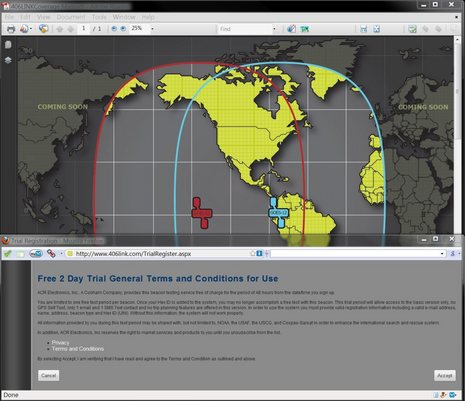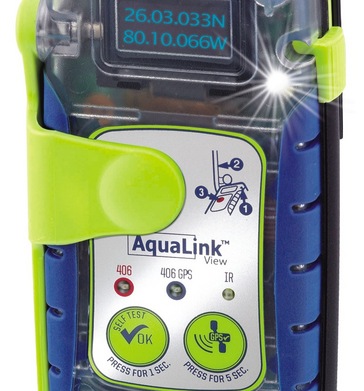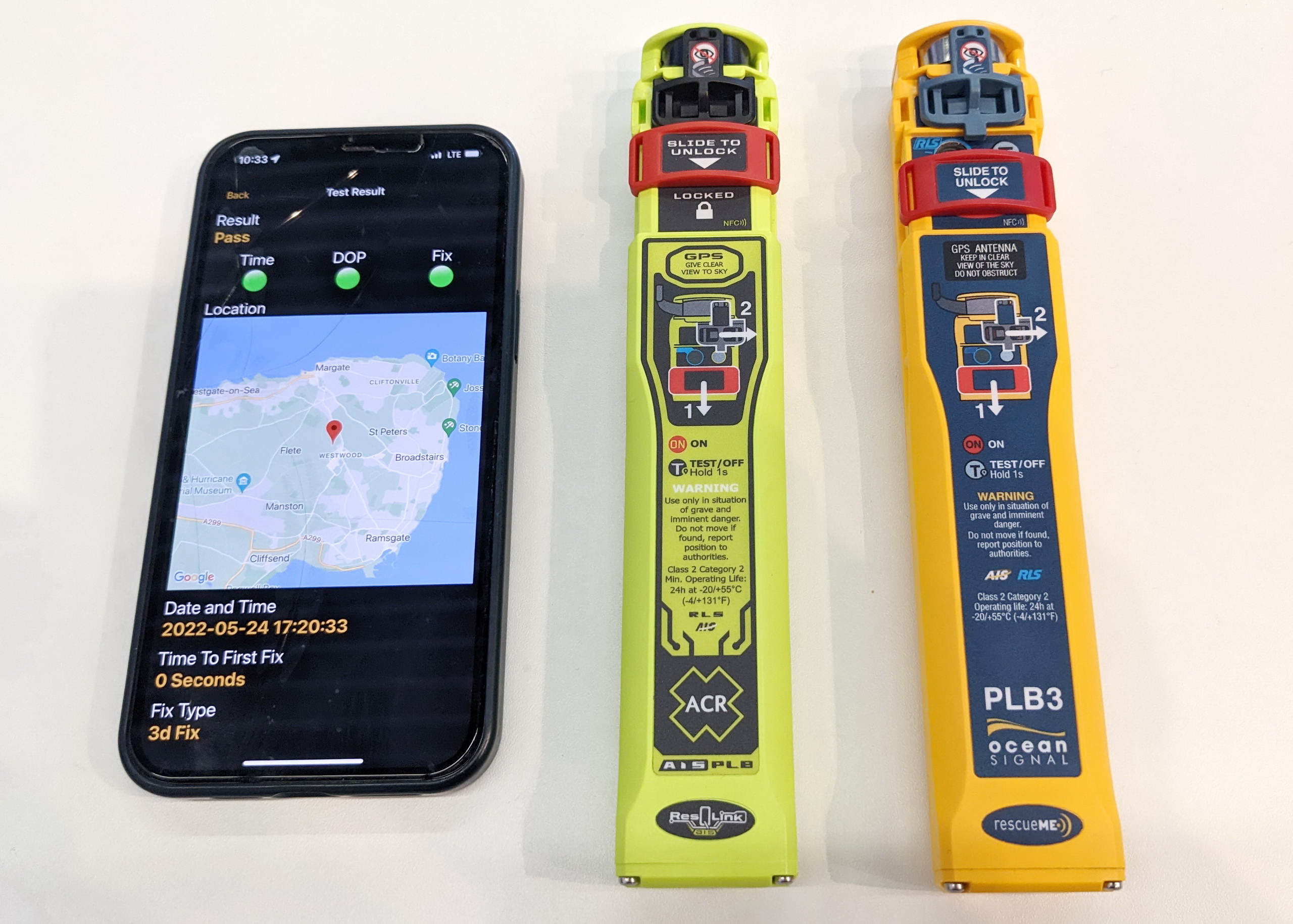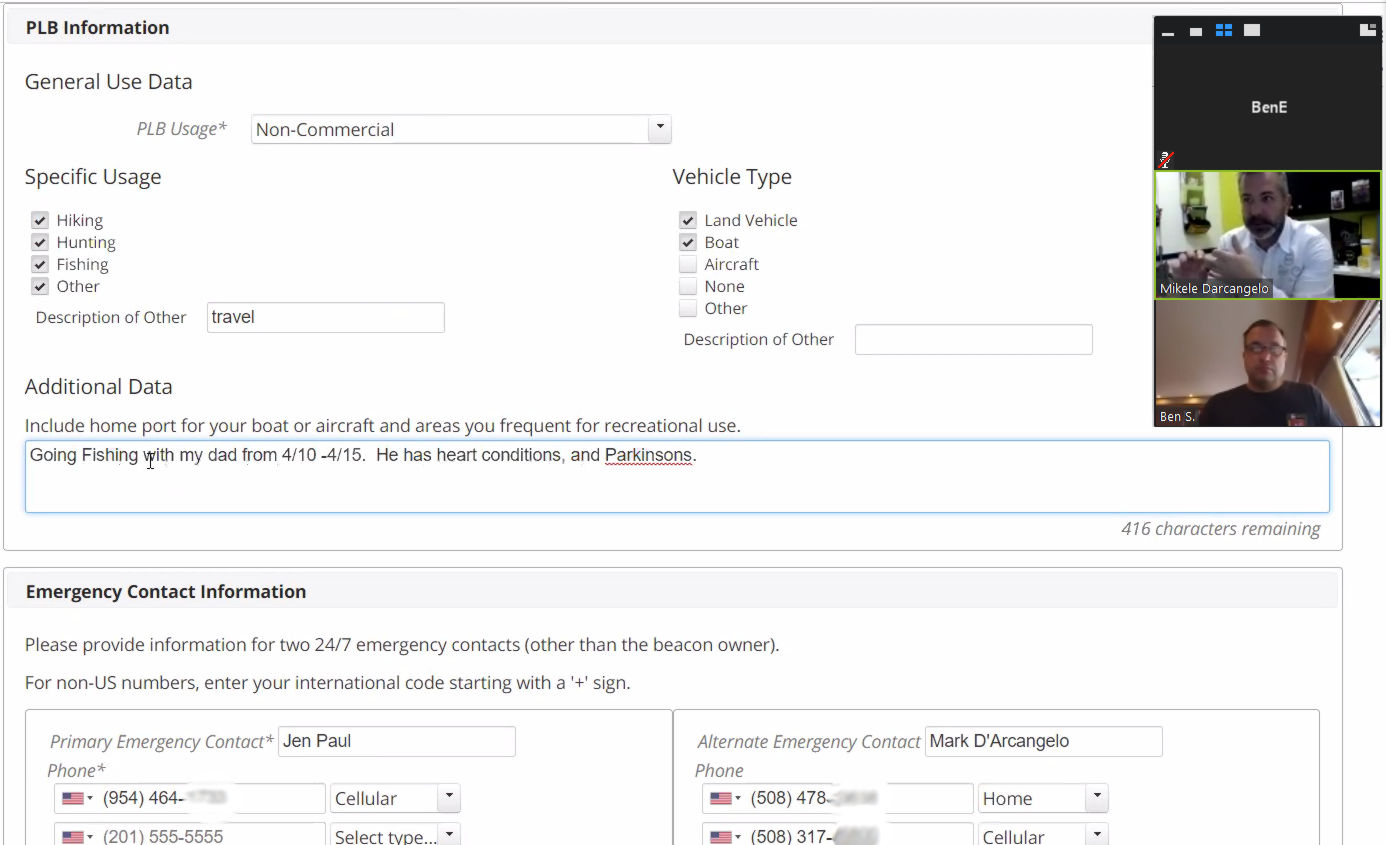ACR, two BIG Miami safety debuts
The new ACR AquaLink View sure looks like the most sophisticated and best performing Personal Locator Beacon (PLB) ever designed. Built-in buoyancy, 6.3 Watts of 406 MHz distress output, a 66 channel GPS receiver, 30 hours of battery life…the specs go on and on. But that’s not all. This PLB is also designed to take maximum advantage of ACR’s new 406Link through-satellite testing service, including its ability to deliver SPOT-like “I’m OK” messages via email and cell phone. 406Link also offers some level of service, even free testing, to the owners of many EPIRBs and PLBs, including lots of models not made by ACR…
What ACR did was to work with, and then purchase, the SaveLife testing system that I wrote about last Spring (following earlier through-satellite testing schemes that promised users a new level of confidence but didn’t seem to pan out). So now a big company with a tremendous reputation amongst beacon users owns ground stations that can pick up EPIRB/PLB test messages fired off anywhere in the Americas or on most of the adjoining oceans (with global coverage “Coming Soon”, as seen below). ACR’s new site 406Link.com explains the service fairly well, and I’m sure it will get filled out with details eventually, but I’ll try to answer some questions that I heard asked Miami.
Like, “what about battery life?” ACR says that their beacon power management is getting ever better, and thus the AquaLink View can deliver some 400-500 test messages without GPS and 60 with GPS without affecting the required 24 hour working life even after 5 years and at 0 centigrade. In fact, the PLB won’t let you run so many tests that you violate that battery reserve. “What about the OK messages?” As best I can tell, the $40/yr 406Link Basic subscription just messages the user indicating that the distress call got received by a GOES satellite, while the $60/yr Plus subscription adds two different canned messages, each addressed to a different list of five contacts, depending whether you do a non-GPS or GPS-included test. It’s not nearly as versatile as what SPOT does (and is working on), but I suspect that a careful skipper could make very good use of 406Link’s limited messaging ability, or at least take comfort in the tool’s availability offshore.
“And just which EPIRBs and PLBs does 406Link work with?” Well, ACR has a list up, but it’s not detailed about, say, the number of tests a particular unit can tolerate or its GPS testing ability (pretty rare, I think). There’s also a FAQ where you’ll learn among other things that beacon testing is as sure thing as actual use since only a single burst is sent. But the great news is that 406Link is offering a free one-time test for any beacon that’s able. The link, illustrated below, is on the lower right of the main 406Link page, and the test has to be done within two days of signing up. I’d do it myself if I owned a beacon, and I’m hoping that many of you will give it a try and report back.

I’m hoping that ACR will loan me an AquaLink View so I can test 406Link hard, and besides I’m pretty intrigued with unit itself. The manual page below (downloadable here) doesn’t even show all the messages it can display on its little LCD when you’re actually in trouble (and might really appreciate some reassurance that it’s working). There’s a whole other set of messages covering testing. While the McMurdo FastFind (which can’t be tested through the satellites) may remain the value PLB, the AquaLink View doesn’t seem expensive at maybe $150 more.















It seems a great value. Remains the extremely high costs of the battery! Approximately 300 dollar! SPOT however works on 2 AA lithium and SPOT2 works on 3 AAA lithium batteries.
But, Reinier, PLB batteries have to last five years and still produce ample power for 24 hours of operation in adverse conditions, and they’re tightly regulated and tested to do so. Plus the batteries are changed by an authorized service which also checks the unit out, changes gaskets, etc.
Power management is just one of many factors that make SPOT and PLBs very difficult to compare. The vague truth: SPOT is primarily a messaging and tracking tool with an interesting but unsanctioned distress component, while PLBs are primarily distress beacons tightly integrated with a global SAR system, some of which are now getting limited messaging/location abilities.
Its like comparing Apples and Juju beans; One is seriously healthy and critical to safety of Life at Sea; the other is, well, candy.
Dear Ben, altough the SPOT is a messaging tool the distress function of the SPOT is not quite the same as an Epirb or PLB. We have tested the 9-1-1 function with the Dutch Coast Guard and the Dutch Safety Organisation KNRM, because we wanted to know if the SPOT 9-1-1 function really works on the water. GEOS call center works regarding the SAR regulations. The same as when an Epirb or PLB is being activated. We ourselves say to the people that the SPOT is not to be compared with an Epirb or PLB as the SPOT is not activated by water contact. The SPOT however has functions which an Eprib or PLB does not have. This new feature of ACR is nice. Here in Europe we also have the problem that an Epirb or PLB can not be used at land, only on the water due to regulations. When an Eprib or PLB is being activated at land the signal will go to Toulouse France and they do not warn the police when the signal is coming out of the Swiss alps. GEOS America however will contact an emergency center after a SPOT message, to help the person in need. Always nice to discuss the SPOT. Best regards, Reinier
So if the battery replacement is $300, and you can only send 60 gps based “I’m ok” messages, the math isn’t very compelling to use this feature (even before the monthly fee).
That’s $5/message folks before the service fee.
Doesn’t sound like such a great feature to me.
Now if they allowed you to use an external power source for the text/gps messages, that would be useful. Using the primary battery, not very useful.
Greg, You’re supposed to change the batteries on EPIRBs and PLBs every five years whether you test the thing or not. I’m not sure that the replacement really is $300, but whatever it is doesn’t really pertain to these new services, unless you used the test/message function so much you ran the battery down before five years.
There’s no question that the messaging ability, especially if you want to include position, is quite limited in terms of times you can use it. However, I can see how some boaters would be happy enough using it with great discretion.
The big question to me is reliability. The whole SARSAT/EPIRB/PLB system is tremendously reliable when it comes to distress messages, but the test/message is only sent once, and if you’re doing it offshore you may have no way to know that it got there.
But I learned today that ACR is going to let me try an AquaLink View and the 406Link Plus service. I plan to use a lot of the message potential as soon as I can, and in as adverse conditions as I can, in an attempt to test the through-satellite test/message reliability factor.
Though I live close to ACR in South Fla I cannot find any price/availablity/procedure on the battery replacement. They need to be more forthcoming with the real cost of owning one of these things.